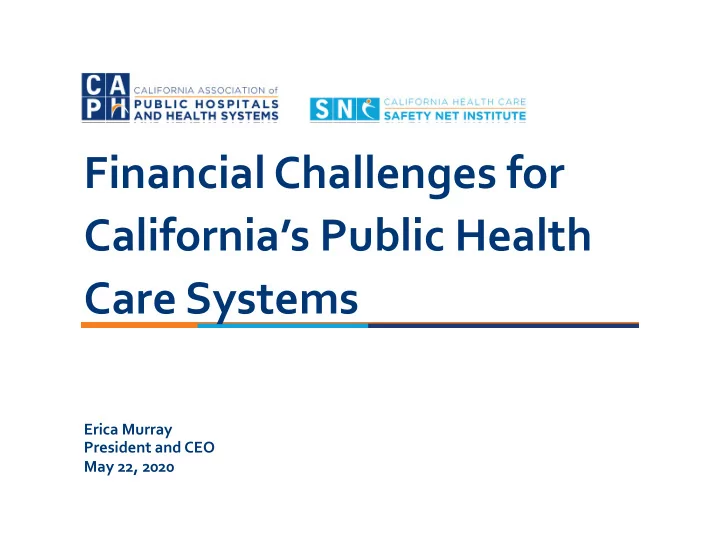

Financial Challenges for California’s Public Health Care Systems Erica Murray President and CEO May 22, 2020
Objectives • Introduce myself, CAPH/SNI • Observations of PHS statewide • Put AHS’s financial circumstances into context to try to appreciate what is common & what is unique 2
About CAPH/SNI • California Association of Public Hospitals and Health Systems (CAPH) • Advances policy and advocacy efforts that strengthen the capacity of its members and ensures access to high ‐ quality, culturally sensitive, comprehensive care • California Health Care Safety Net Institute (SNI) • Designs and directs programs that accelerate and spread innovative practices among public health care systems and helps providers deliver more effective, efficient, patient ‐ centered care 3
21 Public Health Care Systems Just 6% of hospitals in the state, but… • Provide 35% of all hospital care to Medi ‐ Cal beneficiaries in the state in their communities • Provide 40% of hospital care to the remaining uninsured • Operate more than 200 outpatient clinics • Serve more than 2.85 million Includes county ‐ owned and ‐ operated health systems and UC medical systems patients annually 4
April 2019: anticipating waiver expiration • Public health care systems have been financed through 1115 Medicaid waivers for 15 years • Since 2005, California implemented three 5 ‐ year 1115 Medicaid waivers: • 2005: Early Coverage Expansion • Health Care Coverage Initiative • 2010: Unprecedented Delivery System Reform • Delivery System Reform Incentive Program (DSRIP) • 2015: More Ambitious Value ‐ Based Reforms • Medi ‐ Cal 2020 5
1115 Medicaid Waivers • Waiver funding and other supplemental payments are necessary because: • Medi ‐ Cal rates are so low • The State shifts burden of financing onto counties and public health care systems • Resulting in the ”50 cents on the dollar” problem – where public health care systems and counties are required to provide the 50% match • The ACA was a critical game ‐ changer for public health care systems, but PHS are still not covering our costs 6
Medi ‐ Cal 2020 Waiver • The current Medi ‐ Cal waiver is worth a total of $7.4B in federal funds over five years • Three core programs relevant to public health care systems: • Public Hospital Redesign and Incentives in Medi ‐ Cal (PRIME) • $24.6M per year for AHS • The Global Payment Program (GPP) • $79.3M per year for AHS • Whole Person Care (WPC) • $28.3M of federal funding for AC Connect per year 7
What Could Succeed the Waiver? • Directed payments – supplemental payments within managed care rates • Had already created EPP & QIP • AHS disadvantaged by initial lower rates • PRIME to roll into QIP • “CalAIM,” a.k.a. Future of WPC • Significant State GF in Jan Budget • Enhanced Care Management (ECM) • In ‐ lieu of services (ILOS) • GPP • Could continue in an 1115 waiver, but without the Safety Net Care Pool 8
Where Are We Now • The paradox of self ‐ financing continues: both a solution and a structural problem • CalAIM is off the table for now (and probably in the near future) • Anticipating looming DSH cuts, damaging federal regs (MFAR) • We need at least a 1 year extension of the 1115 waiver • No obvious next phase after December 2021 9
Waiver Extension & Other Details • DHCS in negotiations with CMS • Potential problem with budget neutrality • HEROES Act language would waive BN • Seeking to add back the SNCP into the GPP • But move PRIME into QIP to leverage additional FMAP • Also seeking: • An “emergency” 1115 waiver to support & stabilize PHS • CMS unwilling to consider until other funds allocated • Flexibilities for PRIME, QIP, and WPC 10
Commonalities & Distinguishing Characteristics for AHS Common • Structural deficit: victim of our own success • Strength of local collaboration, espWPC • Strong outpatient delivery system, important for PRIME & QIP performance metrics • Directed payment challenges: delays in payments, uncertainty, actuarial soundness Unique • Directed payments still low • Debt to county 11
Recommend
More recommend